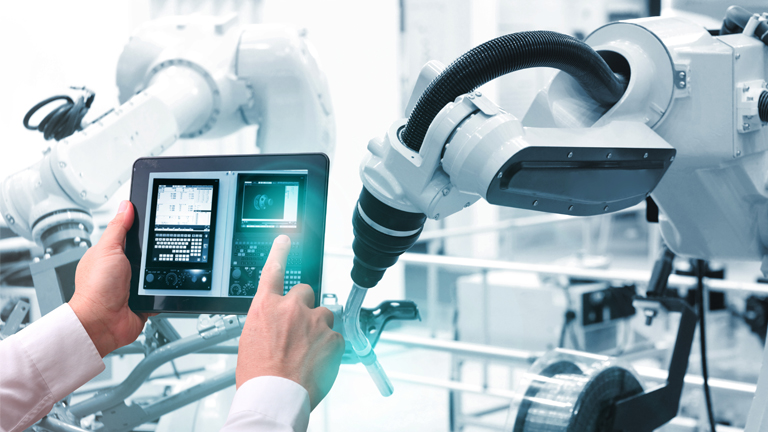From Predictive Maintenance to Collaborative Robots
Artificial Intelligence can become a driver of growth for industry: according to a survey by management consultants McKinsey, GDP in Germany alone could rise by as much as 4 per cent, or EUR 160 billion, more than without AI by 2030 thanks to the early and concerted deployment of intelligent robots and self-learning computers.
“AI promises to deliver benefits not only economically, but also in terms of business management: it enables employees to leave repetitive or hazardous tasks to computers and robots, and focus themselves on value-adding and interesting work,” says Harald Bauer, Senior Partner at McKinsey’s Frankfurt office.
AI and machine learning are exploiting opportunities in connection with Industry 4.0 in particular because enabling a production operation to organize itself autonomously and respond flexibly takes huge volumes of data. Computer systems autonomously identify structures, patterns and laws in the flood of data. This enables companies to derive new knowledge from empirical data. In this way, trends and anomalies can be detected – in real time, while the system is running.
Proactive intervention before the machine breaks down
Predictive maintenance, particular offers genuine potential for rationalization. Large numbers of sensors capture readings on the state of a machine or production line, such as vibration, voltage, temperature and pressure data, and transfer it to an analysis system. The data analysis enables predictions to be made. When are the systems likely to fail? When is the optimum time to carry out maintenance? This can reduce – or even rule out – the risk of breakdowns. McKinsey estimates that plant operators can improve their capacity utilization by as much as 20 per cent by planning and executing their maintenance predictively. As one example, German start-up Sensosurf integrates force sensors directly into machine components that have no intrinsic intelligence of their own, such as flanged and pedestal bearings, linear guides and threaded rods. “We are working in areas where there has been little or no information available to date,” says Dr. Cord Winkelmann, CEO of Bremen-based company Sensosurf. The data obtained in this way is interpreted with the aid of custom machine-learning algorithms. As a result, specific irregularities can be detected and breakdowns prevented, for example.
Listening to make sure the machine is running smoothly
The intelligent Predisound system from Israeli company 3DSignals does not measure the deformation or vibration of a component, but instead records the acoustic sounds of a machine. Experienced machine operators and maintenance staff are able to determine from the sound of a machine whether it is running smoothly. In the ideal case, they can even predict impending breakdowns. Such detection measures are of course not entirely reliable – and they tie up personnel. Predisound aims to solve both those issues. The system consists of large numbers of ultrasonic sensors installed in the machines being monitored. The sensors record the full sound spectrum during the machine’s operation, and transmit the data to a centralized software program based on a neuronal network. By applying so-called deep learning, the software gradually recognizes ever more precisely which variations in the sound pattern might be critical. This means that anomalies which would be indiscernible to a human can be detected. Based on predictive analytics algorithms, the probability of failure and time to failure of individual machine components can be predicted. The maintenance engineer is automatically notified before any damage occurs that might cause a machine to shut down. As a consequence, fixed inspection intervals are no longer necessary.
More effective quality control
Another key area of application for AI alongside machine maintenance is industrial image processing. Automatic pattern recognition by means of cameras and sensors enables faults and their causes to be detected more quickly. That is a great aid to quality control. Bosch’s APAS inspector is one example: it uses learning image processing to automatically detect whether or not the material surface of a production component conforms to specifications. The operator teaches the machine once what non-conformity it can tolerate, and when a component has to be taken offline. Artificial Intelligence then enables the machine to autonomously apply the patterns it has learned to all subsequent quality inspections.
Robots learning independently
Thanks to AI, industrial robots are also increasingly becoming partners to factory staff, working with them hand-in-hand. One example of a collaborative robot of this kind is the Panda from Franka Emika. It is a lightweight robot arm capable of highly delicate movements. The medium-term aim of developer Sami Haddadin is to turn Panda into a learning robot that no longer has to be programmed. The human controller specifies a task to perform, and Panda tries out for itself the best way to perform it. The key feature is that once Panda has found the most efficient method, it relays the information to other robots via the cloud. This means the production company does not have to invest in costly and complex programming. “We are just at the beginning of an exciting development,” asserts Matthias Breunig, a Partner at McKinsey’s Hamburg office. “Key to the beneficial application of AI is an open debate as to how and where humans and machines can work together advantageously.”
****
This article is also available in German language. Click here for the German version. 
ebv content library/articles/from-predictive-maintenance-to-collaborative-robots
From Predictive Maintenance to Collaborative Robots | EBV Elektronik


